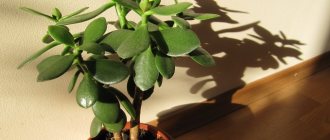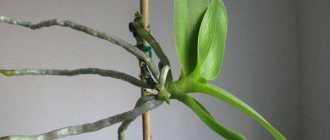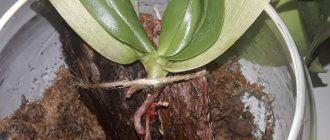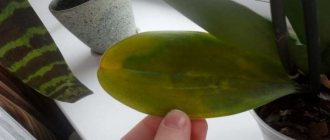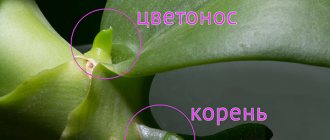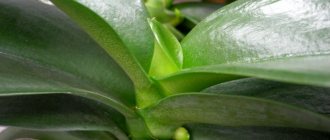Propagation of orchids is a rather troublesome and painstaking task . However, if you have set a specific goal to get children of your favorite orchid (phalaenopsis), then you need to know how to grow them correctly.
Otherwise, there is a risk of getting the wrong result or harming the plant.
How to grow a baby from an orchid stump?
A piece of stem can also result from rotting of the upper part of the plant. Many people simply throw away such stumps, considering them no longer viable. Everything will depend on the quantity and quality of the root system. Phalaenopsis are ready to fight for life with all their might.
You can use the following tips:
- It is very difficult to save a completely rotten orchid, so do not wait for all the leaves of the flower to fall off - remove the phalaenopsis from the pot and check the condition of the roots for rot and disease.
- We get rid of damaged roots, wash them in warm water, treat all sections with activated carbon and dry them. The roots can be placed in a fungicide solution to prevent the development of diseases.
- Replant into fresh pine bark substrate.
- It is important to maintain temperature and lighting conditions. We adhere to the rules of watering and maintenance in apartment conditions.
- We track the periods of natural leaf change so as not to confuse the norm with pathology.
There is a chance to save the orchid if it is left without leaves and growth point, but with living roots.
The orchid has no leaves, but a stump remains with a large number of living roots. There are meristem buds on the stem. It is worth fighting for their lives to the end and trying to raise a young child. But if the stem is missing, it will no longer be possible to save it. It will take time to resuscitate, but it will be worth it.
In the photo: one of the early rescued orchids. The leaves were all lost, and then two babies grew on the withered stem. One even began to grow a flower stalk. Everything is fine with this.
Examine the roots and assess how viable they are. After the procedure of cleansing the root system from rotten and dry parts (if any), we treat it with any fungicide and let the cuts dry. After inspection, we plant the remaining roots with the stump into the fine bark.
We take care of it the same way as other orchids, periodically spray it with warm water, occasionally water it and wait for the buds to wake up on the stump. The main thing is not to overwater and not allow the roots to dry out too much. Some time will pass and the revived orchid stump from one bud will grow a root baby with leaves, which will begin to develop and grow, then send out a peduncle and bloom.
If the root system is good, either leave everything as is or separate and transplant the grown baby into a separate pot.
It's hard to watch the plant you cherished fade away when the orchid's leaves lose their elasticity and become soft and limp. But it’s even worse to contemplate and do nothing.
An orchid is sometimes a capricious exotic flower , which can lose not only turgor on the leaves, but also shed its leaf blades altogether for a number of reasons.
Therefore, if this happens, you can try to save the plant by resuscitating it. Next, we will tell you how to revive your pet in different situations.
Soil for planting
You can use both moss and pine bark. The first one will need to be irrigated every day, which is not entirely comfortable and is only suitable for those plantings that will be located in conditions of high moisture. Most preference is given to the final type, which makes it possible to acquire the most moisture-intensive soil.
The main thing is to take pieces of at least one centimeter, and not dust. You can buy bark in a special store for gardeners.
To ensure that aerial roots, which are highly sensitive to watering and fertilization, are protected, it is preferable to use two materials. The soil is made with clean pine bark, and sphagnum is placed on top.
Such a soil mixture makes it possible to reduce the orchid’s maintenance requirements. The gardener can irrigate the branch, including with hard water.
Causes of orchid leaf loss
Sometimes the leaf blades of a plant begin to quickly die and the bush quickly loses its foliage. As a result, the orchid itself dies. This happens for various reasons, here are the most common ones.
End of flowering period
Sometimes after lush flowering the plant loses some of its leaves. If these are 1-2 leaf plates, then this should not worry the grower. It’s bad when the bush is left completely without leaves. If this happens, then it is worth finding the reason.
Losing a few leaves after flowering is a natural process.
Natural process
For an adult bush, losing one leaf per year is normal , if at the same time it grows new leaves. This is a natural process of aging of the lower leaves. And this should not cause concern to the gardener.
Poor root condition due to overwatering
When watering is carried out with enviable frequency and a large amount of water, the moisture from the soil does not have time to evaporate, under these conditions the root system of the plant can begin to rot.
A small number of roots will not be able to feed many leaves and the excess ones will begin to die. In this case, it is necessary to urgently begin to grow new roots so that the flower does not completely shed its foliage.
Chemical burn of the root system with fertilizers
If the plant was fed with dry roots, this causes a burn to the root system and it begins to dry out. As the number of roots decreases, the amount of leaf mass decreases.
The flower is fertilized only after watering the wet root system.
Chemical burn of roots.
Drying out the plant
With rare watering, the orchid dries out part of its roots, since they do not receive the required amount of moisture. Then, as usual: no roots - no foliage. need to resuscitate the flower and grow its root system.
How to save a plant without leaves? We will answer further.
General concepts
Conditions for receiving
Plants most often reproduce if they feel great. (There is also the opposite reason - the plant is on the verge of death and wants to continue its species by releasing a baby. But this is a rarer case and no one will deliberately destroy their orhu to get a baby).
Accordingly, the grower must provide the most suitable growing conditions for a particular plant. It is necessary to take care of lighting, proper temperature conditions, watering and nutrition, as well as high air humidity.
It is very convenient to obtain orchid babies after the plant has flowered , when living flower stalks remain. The orchid is fed with nitrogen fertilizers and constantly sprayed.
Growing methods
Raising children can be done in different ways:
- on the peduncle. This is the most common method. After flowering, live flower stalks are left on the plant and cared for as described above;
- from a cutting. Quite an effective way when you need to remove a peduncle from a plant. The arrow is cut into fragments, each with a dormant bud, and placed in a container with a small amount of water;
- from the root. A rather barbaric method, in which the top of the orchid is cut off, leaving a stump with roots, which, in theory, gives off lateral shoots.
Resuscitation of an orchid without leaves at home
There are various methods for resuscitating a plant at home:
- if there are practically no leaves, but normal roots remain , then the flower is planted in a tight pot with a complete replacement of the soil. In this case, it is better to spray the top of the soil than to carry out full watering;
- in case of complete loss of leaves - this method requires the gardener to have time, because if the order is disturbed, then nothing can be done with the plant. To do this, the orchid is taken out of the ground and dipped in warm water for 10 minutes. Cut off all non-viable roots and sprinkle the sections with charcoal. Then they make a mini-greenhouse out of a plastic bottle, put expanded clay and moss on the bottom, then put the remains of the flower on top of it all and cover it with a lid. In this case, it is necessary to ensure that there is some water at the bottom of the greenhouse and add it if necessary;
- It happens that a plant loses its leaf blades due to transportation in winter. In this case, growing new foliage will not be difficult. At the same time, those that have frostbite are removed and the flower stalks are trimmed so that the plant does not waste energy on flowering. The orchid is transplanted into the required soil and carried out the usual care. There are 2 options for development: either the growth point will grow, which is unlikely. Most likely, the remaining stump, if there is foliage on it, will produce a side child. It is due to this that the life of the orchid will be extended.
With complete absence of leaves
If, due to improper care, the rosette of leaves on an orchid has fallen off, how can we reanimate the roots? To do this, you need to examine them and decide how viable they are:
- The roots should be dense;
- Have elasticity along its entire length;
- The color of the roots should be uniform - green or silver;
- If you touch them, they are hard and smooth.
This is a description of healthy roots, but if the roots are black and soft, the process of rotting has begun , due to which the plant itself has lost its leaves. In this case, we save it this way: we cut off all the black and soft places to healthy light tissue.
After following these recommendations, if there are still roots left on the plant, it is planted in the fine bark, where it will build up its root system. If there were no roots and leaves, then the remains of the flower are placed in a greenhouse . This is, for example, a plastic 0.5 l. a glass, at the bottom of which moss is placed, slightly moistened, and a plant is placed on top so that its bottom does not touch the wet moss.
Roots will begin to grow due to increased humidity. These are the resuscitation methods that will help restore the plant.
If there is only one leaf left and no roots
If there is only one leaf left of an orchid without roots, is it possible to save such a plant? It's worth a try. To do this, remove everything from the flower that will no longer come to life - rotten or dry - and leave it to dry for 6 hours, having previously treated all the cuts with cinnamon or charcoal. Then it is worth placing it in a closed system or greenhouse.
If you decide to use a closed system, then put a 4 cm layer of expanded clay on its bottom, then moss, bark and moss again. The flower is planted in this soil. At the same time, water is poured onto the bottom so that it covers only the expanded clay.
When adding water, do not get it on the remaining leaf of the flower. If during such resuscitation the leaf loses its turgor, then it is better to cover it with a jar for a couple of days to increase humidity or wipe the leaf daily with succinic acid. To do this, add one tablet per 200 grams. glass of water.
Without leaves and growing point
Experienced flower growers believe that it is necessary to carry out resuscitation and save the plant.
Is it possible to resuscitate?
While life is glimmering in a flower, it is worth fighting for, and not giving up and throwing away a diseased plant. After all, the loss of the top does not mean that the rest also died.
Technology
If the top has dried out, then it is actively covered with charcoal or foundation ash and this is done periodically so that there is no moisture there. You cannot spray the plant, so as not to provoke rotting.
Result
After about six months , provided that there are no floods or dry soil, the stump will produce lateral children , which can be left on this bush or planted in separate containers.
In the absence of leaves and living roots
If there are no leaves on the orchid for a number of reasons, then if there are healthy roots, it is planted in new soil and grown as usual.
The only thing you need is not to water the roots, but to spray it , since the flower needs less moisture, because there is no surface for its evaporation.
For frostbite
Replant into new soil, treating all areas with foundation. In this case , frozen foliage must be removed from the bush so that it does not provoke rotting. To do this, the sheet is torn into two parts along the sheet. Then each part is torn off separately. After a while, a new growth point will appear on the stump or lateral children will appear.
Aftercare
The planted plant requires additional care:
- 3-4 days after planting in the pot, the baby needs to be watered.
- If the air humidity is insufficient (less than 60%), you should create a mini-greenhouse: cover the pot with the cake with a transparent cap or film.
- Ventilate the greenhouse periodically by removing the cap for several hours.
- When watering (every other time), growth stimulants (Epin, Kornevin) should be added, reducing the dose required for an adult plant by 2 times.
- The container in which the small orchid was planted should be replaced with a larger one after 6-10 months.
Further care is no different from an adult plant.
Video about caring for orchid babies after planting:
What are the reasons for this problem?
The reasons for the falling leaves and lack of roots in an orchid can be different. The most common are the following:
- Incorrect watering. Many inexperienced gardeners believe that the more often you water an orchid, the better for its growth. Actually this is not true. It is necessary to know the size of the flower roots and the period of their activity. It is necessary to water after the substrate has completely dried. To do this, the orchid is planted in a transparent container with holes, where you can see when the plant needs watering.
- Lighting. More precisely, poor lighting, especially in the autumn-winter period. If the normal lighting system is disrupted, the growth of the flower occurs. First, this affects the leaves, which wither, turn yellow and fall off. They, in turn, send a signal to the root system, which also gradually loses its vitality.
- Unsterility of the substrate. If a flower is present in the soil for a long time, then various insects - mites, fungi and other microorganisms - can accumulate in it. They can be both useful and harmful. Some aggressive representatives destroy the roots and foliage of the orchid.
- It happens that the cause of leaf falling and death of the root system has not been established. In this case, the plant is placed in a fungicide. Its dosage should be half that in the instructions. If you regularly treat an orchid this way, its immune system will be strengthened.
How to care for root sprouts
In the scientific literature, the basal baby is called basal. This once again confirms that this plant is entirely dependent on the mother plant, and, therefore, it needs similar care. Essentially, it is an orchid without its own roots, and if you decide to separate the two plants, only one will survive.
In this situation, opinions can be very controversial. Most gardeners consider it reasonable to separate them only if the mother has a diseased root system. Since the new growth is located in close proximity to the growing point, no matter how you separate the two plants, one of them will be damaged.
It is worth noting that there is also successful experience in dividing such plants, but this is rather the exception that confirms the rule!
Next we will look at how to grow an orchid from a baby on a peduncle.
How to resuscitate at home: step-by-step instructions
Is it possible if all the roots and leaves have fallen off?
In this case, urgent resuscitation actions are needed. In this case, the flower is planted in a small greenhouse, which is purchased at a specialized store or made independently from a plastic box. Expanded clay and moss are poured onto the bottom of the greenhouse.
After which the plant is carefully placed there. In this case, good lighting is very important, so you should purchase a phytolamp in advance.
The following procedures are followed:
- Periodically you need to soak the flower in a nutrient solution and water.
- Wipe the base where the leaves should appear with substances to stimulate growth.
- Bathe the orchid in water with the addition of special preparations.
Preparations that are added to water to restore the root system:
- B vitamins. They help restore rotted root systems. The flower needs to be soaked in this solution once a month and wiped once a week.
- Growth regulators. They contain phytohormones that restore the structure of the roots. The plant should be soaked in them monthly (you can learn about effective means for growing orchid roots here).
- Fertilizers based on potassium and phosphorus. They are fed once every 2 months.
- Glucose. If the plant is healthy, then glucose is produced itself as a result of photosynthesis. A sick flower needs feeding containing this substance, since glucose promotes the formation of new cells.
- Microfertilizer with iron chelate stimulates the growth of roots and leaves.
Read more about how to resuscitate an orchid without roots here.
Without growth point
In this case, all rotten roots are removed. This is done using previously disinfected scissors. Then the plant is installed in the water so that its upper part rises above the water. You need to move the container with the orchid to a well-lit place. This way the orchid will begin to recover, and a new root system should soon appear.
We invite you to watch a video about the resuscitation of an orchid without a growing point:
No" not a single sheet
If the orchid’s leaves begin to fall off, but the root remains unchanged, the following restoration tips will help:
- You shouldn’t wait for all the orchid’s leaves to fall off; you need to remove the flower from the pot and inspect the condition of the root system.
- It is necessary to monitor the system of natural leaf change so as not to confuse the natural process with a pathological condition.
- The rules for watering indoors must be clearly regulated.
- If you have just purchased a plant, you should immediately check the roots for rot or diseases (what leaf diseases are found in orchids?).
- If necessary, you need to use an indoor greenhouse.
- From time to time it is worth replanting the flower into a new substrate.
- Strictly adhere to the concept when using strengthening agents.
We invite you to watch a video on how to revive an orchid without leaves:
When does resuscitation no longer make sense?
When all the roots of an orchid have rotted and all the leaves have withered, it will be impossible to save the plant.
But if, nevertheless, small parts of the roots remain in normal condition, then it is worth trying to revive the orchid.
- To begin with, all rotten areas of the plant are removed. Then it dries well.
- Where the cuts were made, the areas are disinfected. This is done using activated carbon. It is crushed into powder, and the sections are treated with this product.
- After this, the areas where future roots should form are treated with vitamin solutions.
- And that is not all. After all these actions, constant care and feeding of the orchid is necessary.


